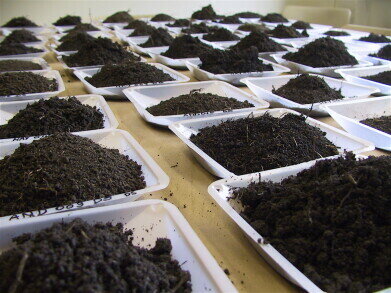Soil testing
What is ‘plasticulture’ – and is it polluting soil around the world?
Jun 21 2024
The agricultural sector has long embraced innovation to improve efficiency and yield. Among the significant advancements is the use of plastics in farming, commonly referred to as plasticulture. This practice encompasses various applications of plastic, including greenhouse covers, plastic mulch, irrigation tubes, hoop houses, and more. While plasticulture has undeniably revolutionized modern farming, it also brings to light critical environmental concerns, primarily the pollution of soil and potential threats to food safety.
Plasticulture traces its origins to 1948 when E.M. Emmert, a horticulturist at the University of Kentucky, experimented with polyethylene sheets as a cheaper alternative to glass for greenhouse sides. This innovation allowed light to penetrate while retaining warmth, creating an ideal environment for plant growth. This early experiment marked the beginning of plastic's widespread use in agriculture, leading to a significant transformation in farming practices.
Today, plastic is ubiquitous in agriculture. It lines greenhouses, covers fields as plastic mulch, forms hoop houses, and serves as irrigation tubes. Satellite images from NASA even show vast stretches of farmland appearing white, dusted with plastic, underscoring the material's extensive use. The agricultural sector is responsible for approximately 3.5 percent of global plastic production, translating to millions of tons of plastic annually.
However, this widespread adoption has a dark side. Over time, plastic degrades into tiny flakes and accumulates in the soil, creating a reservoir of microplastics. These microplastics pose a significant environmental threat, infiltrating various ecosystems, including oceans, rivers, and even human bodies. Studies have detected microplastics in drinking water, seafood, and even the human placenta, highlighting their pervasive nature and potential health risks.
How plasticulture can pollute soil
The Earth's soils, particularly those used for agriculture, have become repositories for plastic waste. Agricultural soils are thought to contain more microplastics than oceans, which hold an estimated 358 trillion plastic particles. These plastics not only originate from farming activities but also from other industrial sources, washed onto farms during floods or carried by the wind. Microplastics in soil can disrupt soil health, affecting microbial communities and soil fertility, which in turn impacts crop yields.
One of the primary challenges in addressing soil pollution from plasticulture is the lack of viable remediation techniques. Removing microplastics from soil is incredibly challenging, and current strategies focus more on prevention than cleanup. The production of plastics, largely driven by fossil fuels, contributes significantly to climate change, which in turn exacerbates the need for plastic in farming to combat extreme weather conditions. This creates a vicious cycle where the demand for plastics grows, further contributing to environmental degradation.
Plasticulture has both benefits and drawbacks. On the positive side, plastic mulch, one of the most common forms of plasticulture, helps conserve water, reduce the need for pesticides, prevent soil erosion, and increase crop yields. It creates a microenvironment that enhances plant growth, providing protection against extreme weather and pests.
However, the environmental implications cannot be ignored. Plastic waste from agricultural activities often ends up in landfills, is burned, or is left in the environment, leading to soil and water contamination. The production and degradation of plastics release greenhouse gases, contributing to climate change. Additionally, the presence of microplastics in soil can have unknown long-term effects on food safety and human health.
Can plasticulture become sustainable?
Efforts to mitigate the environmental impact of plasticulture are underway. Scientists are developing biodegradable alternatives to conventional plastics used in farming. These biodegradable plastics can decompose into natural substances like carbon dioxide and water, reducing their environmental footprint. However, questions remain about their long-term impact on soil ecosystems and their overall efficacy.
Another potential solution is the use of plant-based or recycled plastics, which can reduce reliance on fossil fuels and lower the carbon footprint of agricultural plastics. Innovations in plastic recycling and the development of more sustainable farming practices are essential steps toward reducing the environmental impact of plasticulture.
Plasticulture has undoubtedly transformed modern agriculture, offering numerous benefits in terms of efficiency and crop yield. However, its environmental costs, particularly the pollution of soil with microplastics, pose significant challenges. As the global community becomes increasingly aware of these issues, there is a growing push for more sustainable practices and materials in agriculture.
The future of plasticulture hinges on balancing the need for agricultural efficiency with environmental sustainability. Embracing biodegradable alternatives, improving recycling efforts, and reducing overall plastic use are crucial steps toward achieving this balance. By prioritizing sustainability, we can ensure that the benefits of plasticulture do not come at the expense of our planet's health and the safety of our food systems.
Digital Edition
IET 35.2 March
April 2025
Air Monitoring - Probe Sampling in Hazardous Areas Under Extreme Conditions - New, Game-Changing Sensor for Methane Emissions - Blue Sky Thinking: a 50-year Retrospective on Technological Prog...
View all digital editions
Events
Apr 29 2025 Edmonton, AB, Canada
Apr 30 2025 Ankara, Turkey
May 06 2025 Nuremberg, Germany
May 10 2025 Karachi, Pakistan
May 11 2025 Vienna, Austria








.jpg)





_(4427399123)-(2).jpg)




